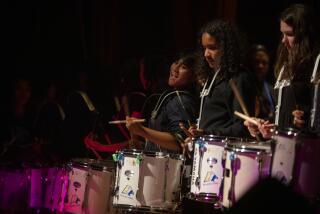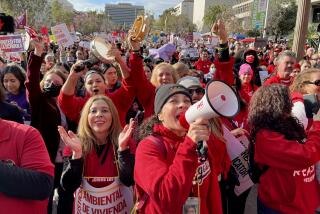LAUSD OKs budget; spending on teachers, needy students to grow

Marking a new direction in school finance, the Los Angeles Board of Education unanimously approved a $6.6-billion budget Tuesday that features the largest funding boost in years and the first-ever blueprint for spending millions of new dollars to improve the academic performance of the neediest students.
Buoyed by more state dollars from a voter-approved tax hike and recovering economy, the 2014-15 budget will more than double the number of new teachers to 1,200, increase librarians, nurses and counselors, reduce class sizes, increase tutoring and improve parent education efforts, among other things.
Overall, the general fund would increase from $6.2 billion last year to $6.64 billion this year. That represents the largest increase since the 2008 recession forced the layoffs of more than 10,000 teachers and other employees and eliminated key services and programs, such as summer school.
“This is the best budget I’ve seen in the seven years I’ve been here,” said board member Tamar Galatzan.
The budget includes $3.6 billion for all students and an additional $838 million for those who are low-income, learning English or in foster care. It is based on the state’s landmark 2013 law that gives districts more dollars for those disadvantaged students — but also requires them to lay out a specific plan on how to use the money to boost their academic performance.
L.A. Unified schools Supt. John Deasy called the spending plan still “woefully inadequate” to cover all needs but said it marked a “trailblazing” turnaround in how decisions are made about how to fund schools.
The budget does not include pay raises for teachers — an omission that drew criticism from United Teachers Los Angeles. The union also said in a statement that the budget “does not go far enough” to reduce class sizes or add counselors, nurses, librarians and other key professionals.
Teachers, and other employees, have not had a pay raise in more than seven years; in fact, they took pay cuts amounting to 8%, the union said in a statement.
Deasy has said he supports wage increases.
Library aides and adult educators also urged more funding. Bizhan Rahbari, a teacher in the adult education program, said the number of instructors had been cut from 3,000 to 600 since the recession.
“We’re working with a skeleton crew,” he said. “It’s just a struggle.”
Community groups voiced some reservations as well. Several speakers urged that $13 million for school police be used instead to hire more counselors trained in alternative disciplinary practices known as restorative justice. At present, the budget provides for only five restorative justice counselors for the nation’s second-largest school system, which has more than 1,000 campuses.
District officials, however, have said they intend to increase that number.
Isabel Gutierrez, a senior at Roosevelt High School in East Los Angeles, said money for police could be better spent on guidance counselors. She sees hers only twice a year, she said in an interview.
“Sure, we’re East L.A., but that doesn’t mean we’re criminals,” she said. “There are also [college-bound] students.”
Deasy has proposed a $21-million increase for more counselors, nurses, custodians and other targeted support to reduce suspensions by 5%, increase attendance by 6% and improve the campus environment. Federal funding for those goals would also increase by $54 million.
Nearly $10 million is proposed to help the district’s 11,604 foster youth, who suffer from the lowest academic achievement of all student groups. The budget calls for more tutoring, counselors and psychiatric social workers to give students a comprehensive academic assessment.
For the 154,110 students learning English, Deasy has proposed more than $21 million for instructional coaches, teacher training and other supports. His plan aims to increase their graduation rates by 3% and boost the number of students moving to full English proficiency by 2%.
Maria Brenes, executive director of InnerCity Struggle, an East Los Angeles advocacy group, said her community members had hoped for more ambitious goals for students learning English and more resources to educate and involve parents.
But she called the spending plan a good first step and hailed the unprecedented community involvement in the budget process. To solicit community feedback as required by the state law, the district held 100 meetings and received more than 10,000 responses.
In reply to calls by school board and community members to give more dollars to needy schools, Deasy pledged to do so through an “equity-based index” that ranks campuses according to their number of disadvantaged students. He included the district’s 14,000 homeless students among them, going beyond the state law.
“What made the last few months historic and unique is that the community has risen to the occasion and really weighed in,” Brenes said. “I think our concerns have been considered.”
Christina Pacheco, advocacy manager at the Arts for LA nonprofit, hailed passage of the budget.
“Today is a win for students,” she said. “We really want to see that the students are equipped with those tools to go out into the creative workforce that is Los Angeles.”
Twitter: @teresawatanabe
Twitter: @haydensaraa
More to Read
Start your day right
Sign up for Essential California for news, features and recommendations from the L.A. Times and beyond in your inbox six days a week.
You may occasionally receive promotional content from the Los Angeles Times.







